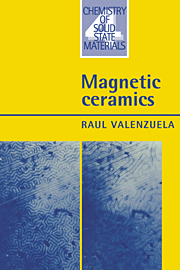6 - Other magnetic materials
Published online by Cambridge University Press: 28 October 2009
Summary
In order to complete this review, a brief overview of magnetic materials other than oxides is presented in this chapter. Soft and hard metallic alloys are discussed first; instead of a detailed account of the numerous alloy systems, this overview focuses on the mechanisms for obtaining specific microstructures, which, in turn, lead to a precise control of anisotropy in soft materials, and to coercivity in hard materials. These discussions include examples of ‘classic’ alloys, as well as the recently developed soft amorphous alloys and the impressive supermagnets with extremely high coercive fields.
Due to their impact on information storage technology, a brief account of materials for magnetic recording media and heads is presented. Materials for magnetooptical recording are also discussed.
The next section deals with magnetic materials and applications that are only now emerging, but which arouse a strong and exciting interest, i.e. molecular magnets, magnetic imaging techniques and non-destructive evaluation by magnetic methods.
The last section is a short review of superconductors; their amazing magnetic properties, as well as two of their present applications are discussed finally. In each section, an effort has been made to indicate new directions in magnetic materials research.
Soft magnetic materials
The basic magnetic properties expected in soft magnets are high initial and maximum permeabilities, μi and μmax, and low coercivity, Hc (lower than ∼ 10 A/m). In many applications, soft magnets are subjected to ac fields; their frequency response and, particularly, their ac losses are therefore important.
- Type
- Chapter
- Information
- Magnetic Ceramics , pp. 223 - 308Publisher: Cambridge University PressPrint publication year: 1994



